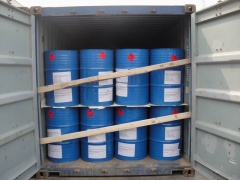Methylethylketone (MEK)
| Infobox on Methylethylketone (MEK) | |
|---|---|
| Example of Methylethylketone (MEK) |  |
| Facts | |
| Origin | - |
| Stowage factor (in m3/t) | - |
| Humidity / moisture | - |
| Ventilation | - |
| Risk factors | See text |
Methylethylketone (MEK)
Contents
Description
Butanone, also known as methyl ethyl ketone or MEK, is an organic compound with the formula CH3C(O)CH2CH3. This colourless liquid ketone has a sharp, sweet odour reminiscent of butterscotch and acetone. It is produced industrially on a large scale, and also occurs in trace amounts in nature. It is soluble in water and is commonly used as an industrial solvent. The product is also soluble in benzene, alcohol and ether; miscible with oils.
Derivation is from mixed n-butylenes and sulphuric acid to cause hydrolysis followed by distillation to separate sec-butyl alcohol which is dehydrogenated, by controlled oxidation of butane, by fermentation.
Butanone is an effective and common solvent and is used in processes involving gums, resins, cellulose acetate and nitrocellulose coatings and in vinyl films. For this reason it finds use in the manufacture of plastics, textiles, in the production of paraffin wax, and in household products such as lacquer, varnishes, paint remover, a denaturing agent for denatured alcohol, glues, and as a cleaning agent. It has similar solvent properties to acetone but has a significantly slower evaporation rate. Butanone is also used in dry erase markers as the solvent of the erasable dye.











